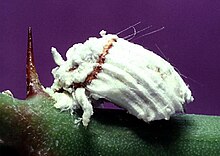Australian scales
| Australian scales | ||||||||||||
|---|---|---|---|---|---|---|---|---|---|---|---|---|

Australian woolen scale insect colony ( Icerya puchasi ) |
||||||||||||
| Systematics | ||||||||||||
|
||||||||||||
| Scientific name | ||||||||||||
| Icerya purchasi | ||||||||||||
| Maskell , 1878 |

The Icerya Purchasi ( Icerya purchasi ) is a scale insect from the family of the cave scale insects (Greek. Margarodes = pearly) (Margarodidae) and the 19th century was already the end of Australia and New Zealand as a pest of citrus known.
features
The wingless females, which have a light orange-red, yellow or brown body color, have a body length of 5 millimeters in the first larval stage, and after the third larval stage they reach a body length of up to 15 millimeters as fully grown adults . The Eisack that they carry is essential for the length, as it is 2 to 2.5 times longer than the female. The body is rounded to oval and arched outwards. Young adult females very soon cover the body, legs and antennae with wax, which is produced in the form of long threads on the sides of the body. The egg sac is then formed from thick white layers of various waxy glandular secretions and is attached to the abdomen . It is always grooved lengthways (14-16 grooves). The elongated oval shaped, reddish colored eggs are laid in it. They have a smooth surface. The number of eggs in the Eisack can be between 100 and 1500.
The very rare males are about 3 to 5 millimeters long and have a dark red body. They have a pair of functional, metallic blue colored wings. The antennae, thorax, and legs are brown.
Occurrence
The animals originally found in Australia are also found worldwide in the warmer areas thanks to the help of humans, who have spread their forage plants worldwide. In California in particular , the animals are numerous in the citrus plantations.
Way of life
The scale insects suck plant sap, preferably from plants of the genera of citrus plants ( Citrus ) and sticky seeds ( Pittosporum ). In its original habitat they are found on acacia ( Acacia ), with which they were introduced and about 1868 or 1869 in California. But they can also be found on other thick, evergreen or woody plants. They cause discoloration, deformities and even drying out on the plants. The secondary damage lies in the secretion of the honeydew , as this allows mold to settle easily . The animals are devastating pests and are common everywhere, especially where citrus plants are cultivated, as their natural predators are lacking.
development
The females are hermaphrodites with the ability to self-fertilize. But they also mate with the rarely occurring males. Males can only hatch from eggs created in this way. There are an average of three generations a year.
Natural enemies
The natural enemies include the ladybug Rodolia cardinalis , which also comes from Australia, and the fly Cryptochaetum iceryae . In the winter of 1888, the ladybird was brought to California for biological pest control by Charles Valentine Riley to control the scale insect plague. The success was already evident the following autumn. This was the first success for biological pest control. To date, about 500 million ladybugs of this species have been bred and released in California.
swell
Biology, harmful effects as well as biological and chemical control options for the Australian wool scale louse (IpM) by Dipl.-Ing. (FH) Marina Smerkol
Web links
- University of Florida: Cottony Cushion Scale (English)
- Cornell University - Rodolia cardinalis (English)
